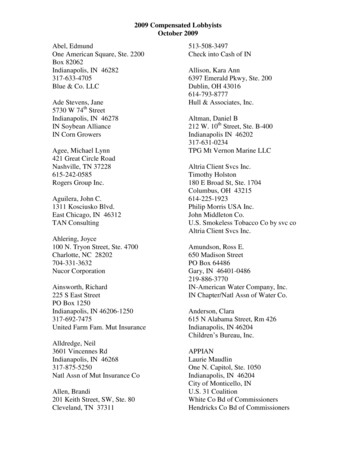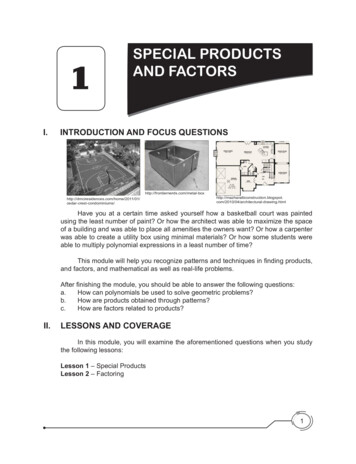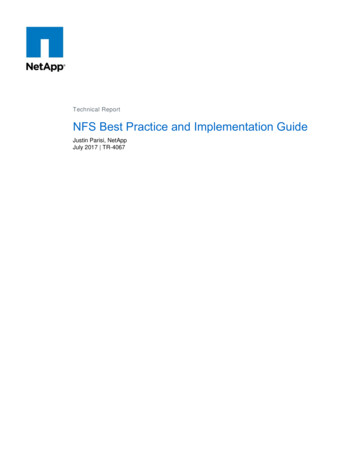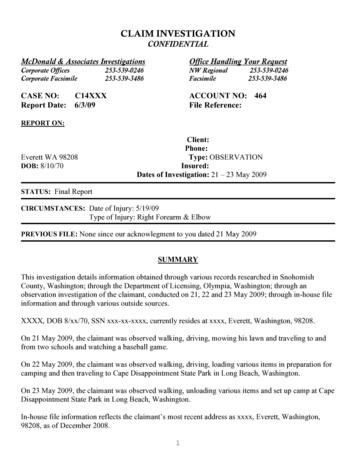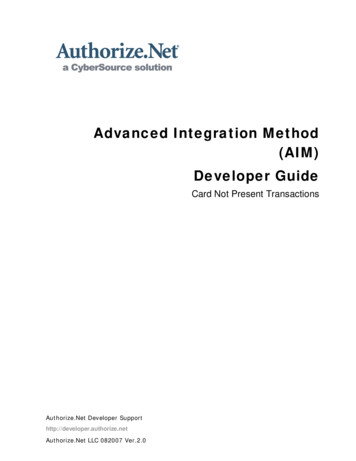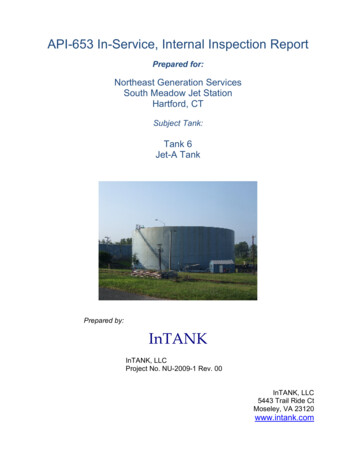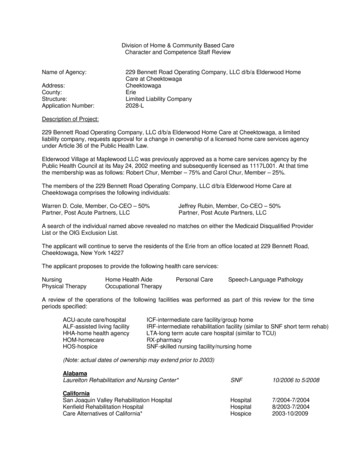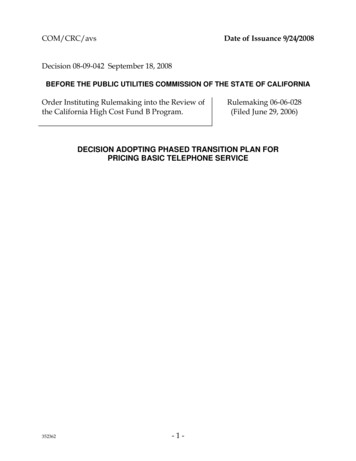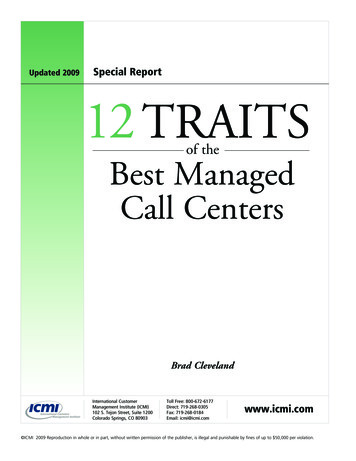
Transcription
Updated 2009Special Report12 TRAITSof theBest ManagedCall CentersBrad ClevelandInternational CustomerManagement Institute (ICMI)102 S. Tejon Street, Suite 1200Colorado Springs, CO 80903Toll Free: 800-672-6177Direct: 719-268-0305Fax: 719-268-0184Email: icmi@icmi.comwww.icmi.com ICMI 2009 Reproduction in whole or in part, without written permission of the publisher, is illegal and punishable by fines of up to 50,000 per violation.
Special Report Twelve Traits of the Best Managed Call CentersTwelve Traits of the Best Managed Call CentersBrad ClevelandIntroduction/ContentsIn some call centers (contact centers, support centers), you can feel the energy as soon as you walkin the door. It takes many forms: pride of workmanship, a feeling of community, good planning,coordination and the willingness to make the “extra effort.” Everybody knows what the mission isand everybody is pulling in the same direction. The call center “clicks.”While there are myriad factors that go into creating this sort of environment, there are 12overarching characteristics that emerge in those customer contact environments that consistentlyoutperform others in their respective industries:n Trait 1: They Produce High Levels of Value. 1n Trait 2: They Have a Supporting Culture. 2n Trait 3: They Know that Their People Are the Key to Success. 5n Trait 4: They Build Plans and Services Around Evolving Customer Expectations. 7n Trait 5: They Have an Established, Collaborative Planning Process. 9n Trait 6: They Leverage the Key Statistics. 12n Trait 7: They View the Call Center as a Total Process. 14n Trait 8: They Understand Technology is (Only) an Important Enabler . 15n Trait 9: They Get the Budget and Support They Need. 18n Trait 10: They Hurdle Organizational Barriers. 20n Trait 11: They Are Willing to Experiment. 21n Trait 12: They See the Possibilities. 23n About the Author. 24n About ICMI. 25Portions of this paper are drawn from the award-winning book, Call Center Management on Fast Forward: Succeeding in Today’s DynamicCustomer Contact Environment (Brad Cleveland, ICMI Press, 2006 – 2009), and other ICMI publications. See www.icmi.com for moreinformation.
Twelve Traits of the Best Managed Call Centers Special Reportn Trait 1: They Produce High Levels of ValueThe best managed call centers have an incessant focus on creating high levels of value for theirorganizations and customers. Far too many organizations are still focused primarily on one level orone dimension of call center value — e.g., to “deliver services efficiently,” “improve revenues” or“boost customer satisfaction.” But leading organizations align their resources, strategy and culture todeliver maximum value on three distinct and interrelated levels.Level one is basic efficiency. Because call centers poolinformation, people and technology resources, they are ahighly efficient means of delivering service. The inventionof toll free service (800 service) in 1967 and the automaticcall distributor (ACD) in 1973 created the ingredients forthe birth of the modern call center industry. But in thoseearlier days, the challenge was to get customers to moveaway from the clientele approach, or the need to talk to aspecific person or reach a specific department.The pooling idea caught on in a big way, and todayour customer contact operations use the same poolingFigure 1: Leading organizations aligntheir resources, strategy and culture toprinciple to handle customer email, web chat, social mediadeliver maximum value on threeinteractions, video, and other types of communication.distinct and interrelated levels.Studies estimate that all other things equal, two call centeremployees can do the work of three others without a callcenter, because of the efficiencies of pooling.Level two is customer satisfaction and loyalty. Call centers can do much more than handle contactsefficiently. They have the means to handle them in such a way that customer satisfaction and loyaltyare improved. This principle, which most managers intuitively understand, has been substantiatedby a growing body of research in recent years (e.g., one widely-quoted study finds that a 5 percentincrease in customer retention rates improves profits by 25 percent to 95 percent).Level three is strategic contribution to other business units. Call after call, hour after hour, day afterday, the call center is capturing information that can literally transform an organization’s ability todeliver effective services. Consider the impact when the call center helps manufacturing pinpointquality problems, enables marketing to develop more focused campaigns, serves as an early warningsystem for potential legal troubles, and works with IT to design better self-service systems. Thebenefits quickly multiply across the organization.Some organizations have made this level of contribution a priority for years. For example, the GEAnswer Center has since the mid-1980s captured customer input and observations of frontlineagents, and used this intelligence for everything from product improvements to targeted marketingwww.icmi.compage 1
Special Report Twelve Traits of the Best Managed Call Centerscampaigns. Managers at Amazon.com often refer totheir call centers as “R&D machines,” and harnessthem to provide information useful for continuouslyimproving services, processes and self-servicecapabilities. And innovative companies such as HP andApple tap their centers as key sources of new productand service ideas. Organizations furthering value onall three levels find that this level of strategic impactrequires supporting measures, objectives, processes andcompanywide buy-in to really be effective — it’s an areaof management that promises much opportunity incoming years.n Trait 2: They Have a Supporting CultureThe Call Center’sContribution to Value I s a major driver of customersatisfaction E nables improved quality andinnovation E nables more focused productsand services E nables highly-leveragedmarketing P rovides efficient delivery ofservices Is essential for cultivating selfCulture — the inveterate principles or values of theservice systemsorganization — tends to guide behavior. It can eithersupport and further or, as some have learned the hard Creates additional revenue/salesway, ruin the best laid plans for organizational change.While there’s no guaranteed formula for creating asupporting culture, many seasoned call center managersagree that shaping culture — or, more correctly,enabling it to flourish — is a primary leadership responsibility. As a result, they spend an inordinateamount of time understanding the organization and the people who are part of it.How do leading call centers create high-performance cultures? How do they communicate theirmission and values in a way that gets buy-in and alignment? Although centers vary dramaticallyfrom organization to organization, there are several characteristics that stand out, includinga commitment to effective communication, a well-defined customer access strategy, and acollaborative planning process.Commitment to Effective CommunicationCommunication creates meaning and direction for people. Organizations of all types depend onthe existence of what Warren Bennis, noted organizational theorist, calls “shared meanings andinterpretations of reality,” which facilitate coordinated action. When good communication is lacking,the symptoms are predictable: conflicting objectives, unclear values, misunderstandings, lack ofcoordination, confusion, low morale and people doing only the minimum required, to name a few.Leaders of high-performance call centers are predisposed to keeping their people in the know. Theyactively share both good news.and bad. This minimizes the rumor mill, which hinders effective,2 page 2007 ICMI, a division of United Business Media, LLC. All rights reserved.
Special ReportTwelve Traits of the Best Managed Call Centersaccurate communication. It alsocontributes to an environmentof trust. As Bennis puts it,“leadership.is based onpredictability. The truth is that wetrust people who are predictable,whose positions are known andwho keep at it; leaders who aretrusted make themselves known,make their positions clear.” Theywork hard to ensure they aren’tsending conflicting messages (seecartoon).Well-Defined CustomerAccess StrategyAmbiguous FeedbackA customer access strategy is a framework — a set of standards, guidelines and processes —defining the means by which customers are connected with resources capable of delivering the desiredinformation and services. An effective customer access strategy includes the following components:Customers: This piece of the plan summarizes how customers and prospective customers areidentified and defined (segmented; e.g., by business or consumer, geography, purchasing behavior,demographics, volume of business, contract arrangements, or unique requirements) and how theorganization will appropriately serve the needs of each.Contact Types: This step anticipates and identifies the major types of interactions that will occur— for example, placing orders, changing orders, inquires, technical support, etc.Access Alternatives: This step — where strategy really begins to hit home for call centers —identifies the organization’s communication channels (telephone, Web, social media, email, IVR,fax, kiosk, handhelds, postal mail, face-to-face service, etc.) along with corresponding telephonenumbers, Web URLs, email addresses, fax numbers and postal addresses.Hours of Operation: This part of the plan identifies appropriate hours of operation and how theymay be different for different contact channels and customer segments.Service Level and Response Time Objectives: This step summarizes the organization’s servicelevel and response time objectives (see Trait 5); different objectives may be appropriate for differentcontact channels and customer segments.Routing Methodology: This part of the plan addresses how — by customer, type of contact andwww.icmi.compage 3
Special Report Twelve Traits of the Best Managed Call Centersaccess channel — each contact is going to be routed and distributed.Person/Technology Resources Required: This step determines which agents or systems will berequired for each customer segment and contact type.Information Required: This step identifies the information on customers, products and servicesthat will need to be accessible to agents and callers; the information that must be captured duringcontacts; how the organization will comply with applicable privacy or reporting requirements; andother related pieces of intelligence.Analysis and Business Unit Collaboration: This step defines how the information captured andproduced during contacts will be used to better understand customers and to improve products,services and processes. Some also summarize major performance objectives and how the call center’svalue and contributions will be measured.Guidelines for Deploying New Services: Finally, the plan should outline a framework for deployingnew services, including technology architecture (corporate standards and technology migration plans)and investment guidelines (priorities and plans for operational and capital expenditures).Your customer access strategy should be a reflection of your organization’s unique brand. Forexample, Southwest Airlines, known as a leading low-cost carrier, doesn’t use extensive IVR menus;after offering a few obvious choices — such as check flight status — callers are automatically routedto a common, pooled agent group. While most airlines use lots of menus to offload calls that canbe automated and to get callers to more specific agent groups, the management team at Southwestbelieves that keeping services simple for customers is a consistent extension of their brand andculture. In another example, Fidelity Investments both encourages self-service when possible andprovides many options and agent groups, reflecting the wide variety of services available from theorganization. Lesson: It’s okay to either go with or depart from accepted practices when that makessense for your organization.An effective customer access strategy provides a blueprint that guides decisions and developments,and contributes to cross-functional communication. When used collaboratively, it is an importanttool for building a supporting culture.Collaborative Planning ProcessCall centers with supporting cultures also have a systematic, collaborative approach to call centerplanning (see Trait 5). Systematic planning improves communication and culture in several ways: It creates a body of information that wouldn’t otherwise be available (“here’s our call loadpattern and, therefore, why the schedules are structured as they are”). It forces people to look into the future and see their work in the context of a larger framework.4 page 2007 ICMI, a division of United Business Media, LLC. All rights reserved.
Twelve Traits of the Best Managed Call Centers Special Report It requires communication about values — on issues such as resource allocations, budgetingand workload priorities.Formal planning goes far beyond getting the right number of people in seats and the IVR systemsized properly (though those are benefits as well). It forces the kind of communication that an activecustomer-focused organization requires.n Trait 3: They Know that Their People Are the Key to SuccessToday’s customer contact centers require increasingly demanding skill sets, at every level. For example: Agents must serve increasingly well-informed and diverse customers; adjust to rapid changesin products, services and technologies; operate in a time-sensitive, multimedia environment;communicate quickly and accurately and in both verbal and written form; understandWeb-, IVR-, and social media-based applications and help customers use those alternativesappropriately. The responsibilities of supervisors are also increasing as they assume roles involving dataanalysis, process improvements and inter-departmental coordination, all of which shape theoverall performance of their teams. The ability to assess and improve performance acrossproliferating contact channels is a central responsibility — and a significant challenge. Call center managers and directors find themselves on a path similar to the one chiefinformation officers (CIOs) traveled more than two decades ago. Just as IT became theorganization’s life-blood, call center directors now answer to higher levels of management andare increasingly involved in shaping strategy to leverage the organization into an improvedmarketplace position. The demands on analysts, workforce managers, trainers and others are also increasing,commensurate with those faced by agents, supervisors and managers.With requirements of all personnel levels within the call center snowballing, the best centers areworking hard to update recruitment and hiring practices — and they are correctly viewing hiring,training and coaching as interrelated issues, and managing them as such (see sidebar).Leveraging Skills and KnowledgeTo keep up with the demands for skills and knowledge, leading call centers are learning to betterleverage the skills and knowledge in their environments. Examples include: Focusing training on the “why” and not just the “how.” That means teaching people why thecustomer contact center is in place, what its purpose is and how it supports the organization’smission. Within that framework, you will, by necessity, communicate the organization’s valueswww.icmi.compage 5
Special Report Twelve Traits of the Best Managed Call CentersThe Hiring, Training and Coaching TrifectaAs is often pointed out, the best call centers do a greatjob of hiring, training and coaching. But the pointthat is sometimes understated is the degree to whichthese processes depend on and benefit each other.Consider hiring. An effective recruiting and hiringprocess ensures that your call center will have the rightpeople for the job. Without it, you’ll be placing a hugeburden on training and coaching — and those processeswill, most likely, be focused on the bare essentials.With it, you’ll be assembling a team that, with the righttraining and support, can work together effectively,support and further the organization’s culture, and adaptand change as the customer contact environment evolves.Some underlying trends have resulted in trainingbecoming increasingly important in the customercontact environment. One that is likely obviousto most is that the environment is becoming morecomplex, requiring robust training that provides astrong and effective base of know-how to employees.A more subtle trend is that many call center managersare placing greater emphasis on finding agents whosupport and further the culture of the organizationand then training them on appropriate skills — ratherthan finding those with the right skills but who maynot fit as well into the culture and environment.Effective coaching is in-the-trenches, hands-on anddirectly focused on specific problems, solutions andopportunities. There’s no hiding from the details, noglossing over the issues at this level. Coaching providesvaluable insight into the hiring process by helpingto identify the traits and makeup of employees whoperform best. And it can and must be a primary feederof training — identifying improvement opportunities,gaps that must be addressed, practical lessons-learned,and other issues that are leveraged when they areaddressed at the group (not just individual) level.In short, hiring, training and coaching are interrelatedaspects of an overall effort. They work best when theyare viewed and managed as such.6 pageand priorities. Agents are muchhappier with their job and servecustomers much more effectivelywhen they see the value of whatthey are doing within a largercontext (see Trait 2). Developing a high-leveragemaintenance training program,which involves analyzingmonitoring and coaching resultsand addressing improvementopportunities at the group level. Building better desktop tools.A more powerful desktopenvironment provides the meansto better accommodate changeand avoid what would otherwisebe an inordinate amount ofgrueling, ongoing training. Developing a structured planfor continued education. Whatshould agents know up front?After six months? After a year?What comes best by experience?Which areas should be covered inthe classroom? Or by mini toursof other areas? Encouraging agents to takethe time necessary to properlydocument calls. Organizations willincreasingly live or perish by thequality of intelligence they captureand use.In the late 1960s, urged on by“Phone Power” pamphlets fromAT&T, many companies began to 2007 ICMI, a division of United Business Media, LLC. All rights reserved.
Special ReportTwelve Traits of the Best Managed Call Centerssee opportunities to reduce or eliminate field offices and field representatives by taking advantageof the newly introduced 800 service. Although these new telephone operators were performing thefunctions of in-person representatives who were typically paid much more (and doing it throughremote channels, arguably requiring even higher-level communication skills), their pay was tied toclerical schedules — an odd precedent that call center managers worked for decades to minimize oreliminate.But today’s trends are clear. Successful call center managers understand the enormously importantrole that customer interactions have in building an organization’s brand and value proposition,especially in an era of increasingly pervasive and influential social networks. They are hiringpeople with more education and giving them more responsibility. And they are successfully anddramatically boosting the organization’s perspective of the importance and value of these positions.n Trait 4: They Build Plans and Services around Evolving Customer ExpectationsThe expectations customers have of organizations are evolving rapidly, pushed by a simple butpowerful dynamic in the global economy: innovationsand improvements in services shift customer demands.The Ten Key CustomerAs of this writing, the world is approaching twoExpectationsbillion internet users and four billion mobile phonesubscriptions (sources: Internet World Stats and1. Be accessibleWireless Intelligence, respectively). Cliché as it may be,2. Treat me courteouslywe are truly becoming a connected world — and theexperiences your customers have with any organization,not only others in your vertical industry, help to shapetheir perceptions.Fortunately, zeroing in on customer expectations isnot the hit-or-miss proposition it may seem. ICMI hasfollowed this issue for nearly 25 years, and we’ve found10 customer expectations that consistently emerge fromcustomer feedback and surveys.The real challenge, of course, is in defining what theseexpectations mean. A couple of decades ago, beingaccessible may have meant having a call center thatworked reasonably well. Today, multiple channels ofaccess, 24x7 operations and one-stop, once-and-donecontacts have become well-established practices. Andthe customer contact environment continues to evolve:Advances in social networks, Web-based services, mobilewww.icmi.com3. Be responsive to what I needand want4. Do what I ask promptly5. Provide well-trained andinformed employees6. Tell me what to expect7. Meet your commitments andkeep your promises8. Do it right the first time9. Follow up10. Be socially responsible andethicalpage 7
Special Report Twelve Traits of the Best Managed Call Centersdevices and telematics (vehicle-based navigation and communication systems) are examples ofdevelopments that are furthering expectations of accessibility.While courtesy used to refer primarily to the way agents handle calls, the definition today is alsosystems- and process-dependent. Get customers to the right place at the right time. Don’t makethem repeat the same information. Don’t transfer them around. And don’t make them go over theiraccount history again.Definitions of responsiveness and promptness are also evolving. Consider email response times, which haveseen significant revisions in recent years — from several days to 24 hours to a matter of hours in manyorganizations. Some organizations are staffing for email contacts similar to inbound phone calls andare handling them as they arrive.Customers also expect all contactchannels to be integrated and workUsing Agent-Level Customer Feedbackseamlessly: They expect changes theyUnbeknownst to them, customers are becomingmake to an account online will becoaches. While, historically, call centers have reliedreflected in the records that agentssolely on supervisors and/or quality assurancecan access, as well.specialists to rate contacts and provide agents withfeedback, Hilton Reservations, Wells Fargo BankerAnother common expectation —Connection and other progressive centers are goingprovide well-trained and informedstraight to the source to find out just how a particularemployees — continues to challengeagent performed on a call, email, chat session or othertype of contact.many organizations. With multiplechannels of contact and betterGathering agent-level customer feedback typicallyinformed consumers, this is asinvolves a brief survey (usually around five to 10important as ever. Leading callquestions) that focuses on a specific transaction thattook place between an agent and a customer, and thatcenters are making monumentalseeks to find out how satisfied the customer was withefforts to update recruiting andthat contact and/or agent. These surveys typicallyhiring practices, educate agentsinclude questions that are related to the key criteriaand managers, and implement thealso included on the call center’s monitoring form.Common survey methods include outbound calls,necessary tools and processes.IVR surveys or Web/email surveys.Tell me what to expect. MeetOne of the main reasons why such feedback is a hit inyour commitments and keep yourcall centers is that it is a hit with agents. Most find itpromises. Do it right the firstmuch easier to accept an assessment of their performancetime. Follow up. These issuesthat includes feedback from the person who was directlyinvolved in the contact, rather than from a third-partyare inextricably interrelated andobserver alone. And the more palatable and trusted arequire that people, processes andperformance assessment is, the more likely an agent is totechnologies work in sync. Foraccept it and to strive to improve.example, automated replies toemail messages can help establish8 page 2007 ICMI, a division of United Business Media, LLC. All rights reserved.
Twelve Traits of the Best Managed Call Centers Special Reportresponse time expectations. Complementing the automated replies are forecasts, schedules, tools andtraining that ensure contacts reach the right agents at the right times and are handled appropriately.Similarly, commitments that call center agents make must be backed up by people, processesand technologies across business units to ensure that orders, deliveries, account changes, etc., arehandled as promised. Customers seem to live by the mantra “trust, but verify” — they’ll trust yourorganization if you fulfill your end of the bargain.Be socially responsible and ethical. Lapses, or even perceived lapses, in an organization’sresponsibilities quickly make the rounds in networked communities. Thousands of new websites,blogs and consumer communities emerge daily, and customers increasingly search out and shareexperiences with others. This issue goes far beyond avoiding blatant malfeasance — organizationsmust make sure they live up to their responsibilities to be open, accessible, and responsive.Given the central nature of these expectations in driving services, the best call centers ensure thattheir management teams thoroughly understand them. Many post them prominently. And theywork considerations of them into all decisions, large and small. (We know of one director whohad her team managers literally memorize the list.) They ensure that these expectations form thecontext in which the customer access strategy is deployed.In short, knowing your customers and anticipating their expectations is essential to developingeffective customer contact services. Yes, it’s a challenge. But evolving customer expectations presentan enormous opportunity for organizations to differentiate themselves in a challenging and alwayschanging economy.n Trait 5: They Have an Established, Collaborative Planning ProcessICMI developed and has long used this definition for call center management: “Call centermanagement is the art of having the right number of properly skilled people and supporting resourcesin place at the right times to handle an accurately forecasted workload, at service level and withquality.” It can be boiled down to two major objectives: 1) Get the right resources in the rightplaces at the right times; and 2) do the right things. Or more succinctly, deliver accessibility andquality.To accomplish these objectives, a systematic planning and management process is required, whichcan be summarized in nine steps:Step 1: Establish Accessibility Objectives. Accessibility — expressed as service level or responsetime, depending on the type of contact — is at the heart of effective contact center management.Accessibility objectives are essential in defining staffing and network requirements, and associatedcosts. Further, accessibility is an inherent part of quality.Service level, defined as answering X percent of calls in Y seconds, is a concrete and stable objectivewww.icmi.compage 9
Special Report Twelve Traits of the Best Managed Call Centers1.Choose ServiceLevel and ResponseTime Objectives9.Repeat for Higher andLower Levels of Service2.Collect Data3.Forecast Call Load8.Calculate Costs4.Calculate Base Staff7.Organize Schedules6.CalculateShrinkage5.Calculate SystemResourcesFigure 2: A systematic planning and management strategy for deliveringaccessibility and qualityfor transactions that mustbe handled when theyarrive. Inbound calls,video contacts and callsintegrated with the Webthat must be handled whenthey arrive (“call me backnow” and “click to talk”transactions) fit into thiscategory. Targets of 90/20(90 percent answered in20 seconds) or 90/15 aretypical high-end servicelevel objectives, while 80/20is a popular middle-of-theroad target.Response time is theappropriate objectivefor transactions that don’t have to be handled when they arrive, such as customer email, postalcorrespondence, faxes, customer voicemail and Web “call me back later” contacts. Today, manyorganizations have established 24-hour response for customer email, but as noted (Trait 4), someorganizations are handling email and similar text messages as they arrive.Step 2: Collect Data. This step is one of the most involved, politically charged and outwardlyfocused aspects of managing a call center. In fact, a major driver behind the development ofcustomer relationship management software is the need to collect previously fragmented data locatedthroughout the enterprise and unify the information into a shared, customer-focused knowledge basethat is a
The best managed call centers have an incessant focus on creating high levels of value for their organizations and customers. Far too many organizations are still focused primarily on one level or one dimension of call center value — e.g., to “deliver services efficient
